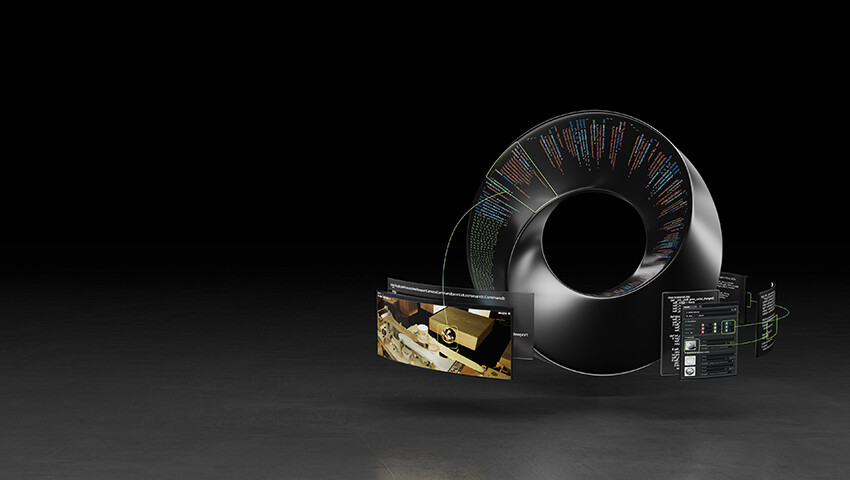NVIDIA is in the midst of hosting their GTC conference this week, showcasing the latest innovations and products, and case studies featuring their tools. Omniverse, the common data environment and metaverse platform that was launched this spring, was a major piece of NVIDIA’s presentations. In addition to several stunning case studies (including a fully digitalized BMW plant), new features and partners for Omniverse were announced.
Beyond the entertainment and gaming applications, Omniverse is a virtual environment with powerful processors that can be harnessed for simulation and digital twin-building. At this year’s GTC, new integrations for infrastructure and industrial digital twin applications were announced, including two powerhouse companies within the AEC and geospatial realm: Bentley Systems and Esri.
Bentley iTwin integration
Bentley Systems’ digital twin platform, iTwin, has served as the backbone for detailed infrastructure projects from single-building scale entire cities, highways and other complex infrastructure. At the spring GTC conference, it was announced that the iTwin platform would integrate with Omniverse to provide a pipeline for AI-enhanced, real-time visualizations and simulations on those digital twins.
With the early access to iTwin in Omniverse (available now), users seeking to build digital twins will now have access to physically accurate, physics-driven and ultra-realistic visualization of their projects. In a blog on NVIDIA’s website, GM of Omniverse, Richard Kerris emphasized that the goal is to make digital twins as realistic as possible.
“With Bentley iTwin for NVIDIA Omniverse, iTwin users have the ability to virtually explore massive, physically accurate industrial plants and offshore structures as if they’re walking through them in real time.”
Geo Week News interviewed Kerris and Lori Hufford, VP of Applications Integration at Bentley earlier this year to discuss how iTwins will work within Omniverse, where they shared their vision for digital twins. Watch now>>
In a recent earnings call with Bentley Systems, CEO Greg Bentley commented on the partnership and its potential for pursuing their goals of enabling 4D construction.
“The challenge for actual infrastructure engineering, however, is that both designed, and as operated physical reality are constantly changing. And much of the value of infrastructure digital twins is an understanding perhaps extrapolating these changes in their implications.”
“4D visualizations use the computing power of NVIDIA's Omniverse to interactively move backward and forward not only in 3D, but also by way of our iTwin platform's TimeSlider backward and forward in an asset's digital chronology to immersively review, for instance, the design history and/or the 4D construction sequence. This killer application for Omniverse is only possible by virtue of an iTwin's unique change ledger which assures that the digital twin can be synchronized with the evolving reality."
During the GTC keynote, several digital twin examples were showcased, including a project by SIEMENS to model a steam generation plant down to the behavior of the water and chemistry of corrosion. While it wasn’t clear whether these twins were built with the iTwin platform, examples like this can clearly demonstrate their value.
New connections to Esri CityEngine
An entirely new (and slightly unexpected) announcement in the fall GTC was the announcement that Esri ArcGIS CityEngine would be connected to Omniverse. With the new integration, users can provide full 3D city models and put them within their geospatial contexts.

Omniverse uses a file format known as Universal Scene Description, or USD render 3D scenes. Originally developed by Pixar, the format has evolved to become the backbone for virtual worlds, and adopted by NVIDIA for Omniverse. With the integration with Esri, this opens the possibility that data from Esri applications may also be able to be exported as USD for use in the Omniverse launcher.
3D city models are used across a variety of industries, and Esri’s CityEngine is focused on architecture engineering and construction applications. However, until now, creating 3D models of existing cities is complex and can have high costs. While survey technologies have gotten better, time and cost are still a factor. Simon Haegler, Software developer at Esri’s R&D Center in Zurich, Switzerland, presented a demonstration of how the CityEngine integration with Omniverse may be able to address those concerns.
“While there is steady progress in scanning and survey technology, we are still far from automatically capturing a 3D model of a city and keeping the resulting data current. This is where the combination of GIS data and procedural modeling can help provide useful, semi-realistic models which are sufficient for applications in architecture, engineering and construction.”
“CityModel combines a strong foundation in GIS with unique functionality and rule-based procedural modeling. This allows for efficient creation of 3D city models based on real world GIS data. This approach is also useful to interpolate or generate any missing data, such as roof details."
This integration can enable entirely new workflows, where massive digital twins – for example for a city or country – can be created. Creating these large-scale models can also provide the datasets needed to test and deploy robotics, autonomous vehicles, or anything else that needs to be “trained” before being deployed in the real world.
The 'HTML of 3D'
The purpose of Omniverse, essentially, is to be the workspace for 3D projects and digital twins – everything from a millimeter-accurate replica of a power plant to ‘Earth 2’ a copy of the entire planet. The platform serves as the common connection between 3D virtual worlds, and harnesses advanced processing and rendering technology to enable detailed simulations and realistic visualizations.
In CEO Jensen Huang’s keynote, he emphasized that the USD format is the future of 3D work.
“We look at USD as an analogy to HTML. In much the same way the early internet was inconsistent between browsers and platforms, HTML solved the plumbing and now all web site experiences are consistent. We believe that USD is doing the same for 3D worlds. Supported by dozens of independent software vendors and companies like NVIDA, Apple and others - the plumbing for consistent across virtual worlds 3D is there."






